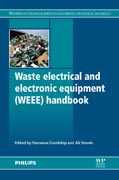
Waste electrical and electronic equipment (WEEE) handbook
Goodship, V.
Stevels, A.
Electrical and electronic waste is a growing problem as volumes are increasing fast. Rapid product innovation and replacement, especially in information and communication technologies (ICT), combined with the migration from analog todigital technologies and to flat-screen televisions and monitors has resultedin some electronic products quickly reaching the end of their life. The EU directive on waste electrical and electronic equipment (WEEE) aims to minimise WEEE by putting organizational and financial responsibility on producers and distributors for collection, treatment, recycling and recovery of WEEE. Therefore all stakeholders need to be well-informed about their WEEE responsibilities and options. While focussing on the EU, this book draws lessons for policy andpractice from all over the world. Part one introduces the reader to legislation and initiatives to manage WEEE. Part two discusses technologies for the refurbishment, treatment and recycling of waste electronics. Part three focuses on electronic products that present particular challenges for recyclers. Part four explores sustainable design of electronics and supply chains, part five discusses national and regional WEEE management schemes and part VI looks at corporate WEEE management strategies. With an authoritative collection of chapters from an international team of authors, Waste electrical and electronic equipment (WEEE) handbook is designed to be used as a reference by policy-makers, producers and treatment operators in both the developed and developing world. INDICE: Part 1 Legislation and initiatives to manage WEEE: Global e-waste initiatives; EU legislation relating to electronic waste: the WEEE and RoHS directives and the REACH regulations; The present recast of the WEEE directive; The WEEE Forum and the WEEELABEX project; Conformity assessment of WEEE take-back schemes: the case of Switzerland; Eco-efficiency evaluation of WEEE take-back systems. Part 2 Technologies for refurbishment, treatment and recycling ofwaste electronics: The materials of WEEE; Refurbishment and re-use of WEEE; Shredding, sorting and recovery of metals from WEEE: linking design to resourceefficiency; Mechanical methods of recycling plastics from WEEE; Pyrolysis of WEEE plastics; Chemical or feedstock recycling of WEEE products. Part 3 Electronic products that present particular challenges for recyclers: Recycling printed circuit boards; Recycling liquid crystal displays; Recycling cooling and freezing appliances; End-of-life options for printed electronics; Recycling batteries. Part 4 Sustainable design of electronics and supply chains: ErP, the European directive on ecodesign; Sustainable electronic product design; Reducing hazardous substances in electronics; Examining subsidy impacts on recycled WEEE material flows. Part 5 National and regional WEEE management schemes: WEEEmanagement in Europe: learning from best practice; WEEE management in China; WEEE management in the USA and India: research and education for a responsibleapproach to managing WEEE; WEEE management in Japan; WEEE management in Africa. Part 6 Corporate WEEE management strategies: Hewlett Packard’s WEEE management strategy; Siemens’ WEEE management strategy; The history of take-back and treatment of WEEE at the Philips Consumer Lifestyle division; Creating a corporate environmental strategy including WEEE take-back and treatment.
- ISBN: 978-0-85709-089-8
- Editorial: Woodhead
- Encuadernacion: Cartoné
- Páginas: 720
- Fecha Publicación: 01/09/2012
- Nº Volúmenes: 1
- Idioma: Inglés
